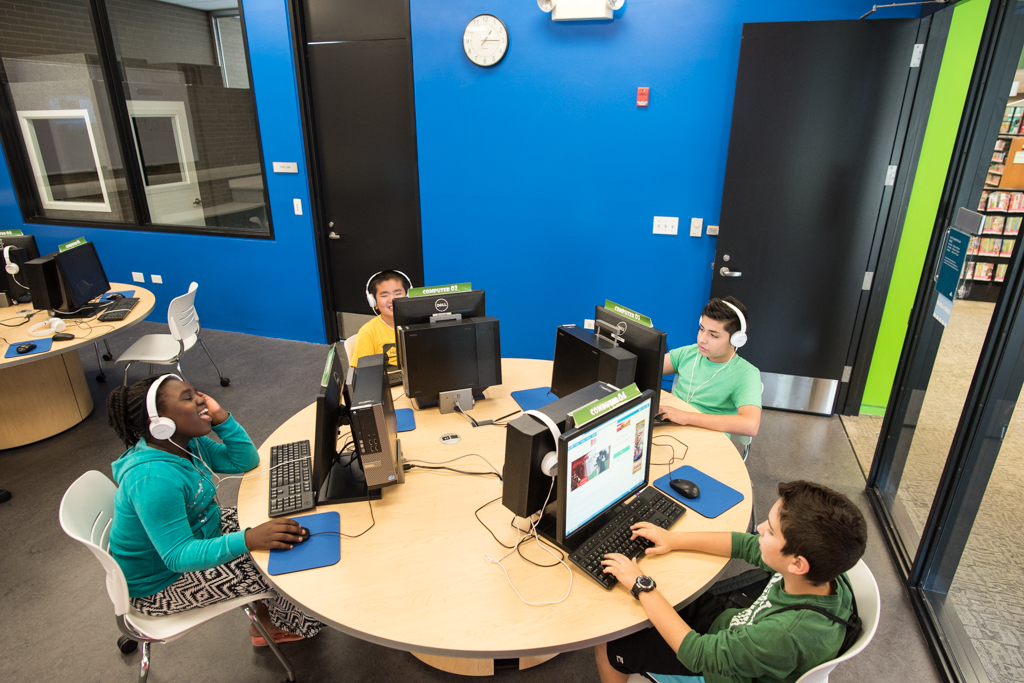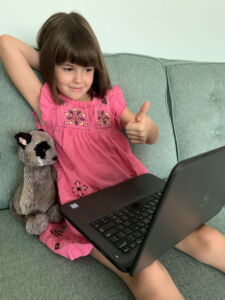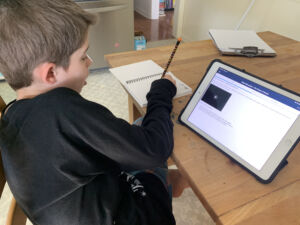Before I get too deep into this post, I feel I must confess that there was a time in my life when I was a skeptic about gaming in the library. This skepticism was based on a number of misconceptions, the best of them being that nebulous old chestnut “you’ll rot your brain,” and the worst of them being that it’s a highly addictive, antisocial activity with little room for creativity. The latter opinion was loosely based on my own experiences obsessively squandering many a perfect summer day in pursuit of eight pieces of Zelda’s triforce. Not that there’s anything wrong with that!
When I began working at a library with an active youth computer lab, not only did my opinion change, I became a lab evangelist. The kids who occupied the space became friends, teammates, and collaborators. Where I expect

Skokie Public Library Youth Lab, 2015
ed zoned out quiet and couch potatoes, I saw vibrancy, exuberance (sometimes a little too much exuberance), peer assistance, and creativity. In a word: connection.
When our library closed due to the pandemic, the Youth services Staff spent a lot of time thinking about how best to serve our patrons and our community. We developed strategies to “meet patrons where they are,” whether that meant storytimes and programs online, or crafting take home supplies to mimic in-person experiences. We adapted, and with varying degrees of success, found ways to offer among other things, cooking programs, art programs, STEAM kits, concerts, storytimes, programs designed to connect and curb loneliness, programs aimed at meeting social/emotional needs. The one experience that remained elusive was that of the Youth Lab in the library.
Late in the winter months, I was approached by our Youth Program coordinator and asked if I would be willing to partner with Erica Nelson, a member of the Experiential Learning team at Skokie Library to develop an online coding program for kids in the library. In pre-pandemic times, Erica spent a lot of time supervising the Youth Lab, and remains to this day my son’s favorite library staff member. I have almost zero experience with coding, but I love learning new things, and I was thrilled to work with Erica.
One of the many wonderful things about working in a library is that there is almost never a need to reinvent the wheel. Whatever it is that you’re thinking of doing, the likelihood is that some library dynamo has probably already tried it. That is absolutely the case with coding. Erica and I wanted to see how other libraries were incorporating coding into their programming, so we watched webinars and pored over different programs, among them: Girls Who Code, Hour of Code, Code.org, etc. before eventually settling on Google’s CS First, which utilizes Scratch. 
Our primary objective was to give kids a fun, safe space to try new things and learn from each other. In essence: to remotely replicate the in-person lab experience. We sampled several of the CS First modules, and found their lessons and presenters engaging and fun, with just the right amount of hands-on activity. Because Erica and I wanted to replicate the collaborative in-person energy from the Youth Lab in our program as much as possible, we looked for ways that we could be available, but largely hands-off, in the hopes that the kids would find ways to work and learn together. We decided to limit the class size to six participants, in order to facilitate collaboration and discovery, then chose a superhero coding module for our first program.
One of the things that drew us to CS First is the way that they’ve tailored their lesson plans to work with remote learning. Each module features a different teacher who provides short, segmented video instruction, then a link where you can try it yourself. The segments build on each other, allowing the participants to curate their own experience. We felt that this would work very well for what we hoped to achieve with our program, and hence, Skokie Public Library’s Code Monsters was born.
Wanting everyone to feel welcome and empowered, Erica and I take time at the beginning of each session to talk through our own experience levels, and where the kids are in terms of comfort with computing. The vast majority of them feel very good tinkering around, but as someone who felt left behind by STEM learning as a kid, I want to make it very clear that coding is for EVERYONE. From there, we go right into the video lesson, then drop the link for the hands-on creation in the chat, and let them get to work. We were a little bit nervous about varying skills levels, but this turned out to be unfounded. The kids who felt most confident were excited to have the time to experiment with the different features of Scratch coding, and those who were struggling a bit could reach out to me, Erica, or oftentimes one of the more experienced participants.
We designed the program to be two hours long, thinking that the first hour would be skills-building, and the second hour would be for sharing and collaborating. It ended up being much more fluid, with chatting, joking, and problem solving happening throughout. We wondered if a two hour program on Zoom was too much to ask, especially after online learning for school, but the kids were engaged and social for the entire program. The modules we used seemed to hit a sweet spot in terms of skill level. The more experienced coders in the group said they were happy to have the refreshers in the basic modules, and the lessons move fast enough that no one felt bogged down. 
In the end, we feel like this is a very successful program, and that we had accomplished what we had set out to do in terms of creating a safe, fun, and creative space for them to explore and play online. As we move into the summer and the next school year, we hope to expand it to accommodate more participants and broaden the age ranges.
If you’d like to try something like this – and I highly recommend it – please don’t hesitate to reach out with questions. I will leave you with one final pro-tip: Have some jokes up your sleeve for the eventuality of technical difficulties!




Great article! I have to ask – did you find Zelda’s triforce? 🙂
Luna, NO!!! I spent a whole summer on it and never got there. I did eventually beat the Ocarina of Time, though. 🙂